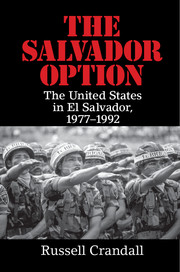Book contents
- Frontmatter
- Dedication
- Epigraph
- Contents
- List of Figures
- List of Organizations
- Acknowledgments
- 1 Introduction
- PART ONE EL SALVADOR IN THE COLD WAR
- PART TWO JIMMY CARTER
- PART THREE RONALD REAGAN
- PART FOUR GEORGE H. W. BUSH
- 39 Elusive Justice
- 40 Pessimism
- 41 Bush Arrives
- 42 Bush, Cristiani, and the 1989 Vote
- 43 Guerrilla Second Final Offensive, November 1989
- 44 Jesuit Killings
- 45 SAMs
- 46 United Nations and Peace
- 47 Demobilization
- PART FIVE POSTWAR
- Notes
- Bibliography
- Index
44 - Jesuit Killings
from PART FOUR - GEORGE H. W. BUSH
Published online by Cambridge University Press: 05 June 2016
- Frontmatter
- Dedication
- Epigraph
- Contents
- List of Figures
- List of Organizations
- Acknowledgments
- 1 Introduction
- PART ONE EL SALVADOR IN THE COLD WAR
- PART TWO JIMMY CARTER
- PART THREE RONALD REAGAN
- PART FOUR GEORGE H. W. BUSH
- 39 Elusive Justice
- 40 Pessimism
- 41 Bush Arrives
- 42 Bush, Cristiani, and the 1989 Vote
- 43 Guerrilla Second Final Offensive, November 1989
- 44 Jesuit Killings
- 45 SAMs
- 46 United Nations and Peace
- 47 Demobilization
- PART FIVE POSTWAR
- Notes
- Bibliography
- Index
Summary
Listen, the problem of this country is not the problem of communism or capitalism. The problems of this country are problems of very basic wealth distribution, of very basic needs. But, when, in this country, you ask for the satisfaction of those needs, you become a subversive.
– Father Ignacio Martín Barró, Jesuit priest murdered by FAES soldiers on November 16, 1989The low point of the Bush administration's human rights policy toward El Salvador was its handling of the case of the six Jesuit priests.
– Human Rights Watch, 1989On November 11, 1989, the first day of their offensive in San Salvador, FMLN commandos destroyed one of the main gates of the leafy Jesuit-run “José Simeón Cañas” Central American University (Universidad Centroamericana “José Simeón Cañas,” UCA) and sought refuge in the academic compound. Days later an FAES force searched the campus grounds and buildings looking for enemy fighters who might still be hiding out. After the search, a military detachment was assigned to record who entered and exited the UCA gates. The FAES also started prohibiting any individuals or vehicles onto the campus without authorization. A few days later, FAES troops conducted another search to pursue what it believed were more than 200 guerrillas who were using the campus as a base from which to fire on the nearby military academy.
While a private institution, the UCA had long been accused by many on the right or in the FAES of being a bastion of pro-guerrilla subversion or serving as “advisors to the FMLN.” The UCA's highly vocal rector, Father Ignacio Ellacuría, had been called by the right “the most dangerous enemy that we have here against our people and the armed forces.” Another rightist smear was that Ellacuría was “the maximum representative of Marxism in the country.” What almost no one disputed was that the university had long been a stronghold for vocal Jesuit priests and their unyielding gospel of radical social change.
During a meeting on the night of November 15, 1989, then head of the army's joint chiefs of staff Colonel René Emilio Ponce, in the presence of generals and colonels, ordered the head of the army's military academy, Colonel Guillermo Alfredo Benavides, to kill the despised Ellacuría and leave no witnesses alive.
- Type
- Chapter
- Information
- The Salvador OptionThe United States in El Salvador, 1977–1992, pp. 442 - 452Publisher: Cambridge University PressPrint publication year: 2016

